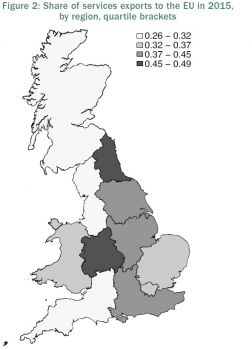Leave-voting regions are “most exposed” to Brexit services shock
By: James Hakner
Last updated: Tuesday, 15 May 2018

The North East and West Midlands are the most reliant on the European market, sending around half of their services exports to the EU. Sources: Office for National Statistics (2017a); and authors’ calculations.
Two of the biggest Brexit-voting regions would be hit hardest by a potential fall in services exports upon leaving the EU, new analysis suggests.
While London is by far the biggest exporter of services, a report today shows that the North East and West Midlands are the most reliant on the European market, sending around half of their services exports to the EU.
The new ‘heat map’ by Dr Ingo Borchert and Nicolo Tamberi from the UK Trade Policy Observatory (UKTPO) at the University of Sussex is the first to describe the rich pattern of UK regional services exports – and how reliant different regions and sectors are on the EU.
As well as regional differences, there are significant variations by sector. Services exports from the motor trade sector are primarily oriented towards the EU, for example, whereas professional services are exported mostly to non-EU destinations.
The research also provides the closest estimate yet of the value of Britain’s ‘hidden’ services exports – around £50 billion a year is generated by services inputs into manufacturing goods, which are subsequently destined for export.
The discussion around Brexit’s potential impact tends to focus on goods trade, even though international trade in services is more important for the UK economy than for most other countries, the researchers say.
Dr Ingo Borchert, Senior Lecturer in Economics at the University of Sussex and Fellow of UKTPO, said: “While London is by far the biggest exporter of services to the EU, it also trades on a huge scale with the rest of the world, so is somewhat protected.
“Other regions are far more vulnerable. The North East and the West Midlands send nearly half of their services exports to the EU and thus their service sectors emerge as the most exposed to potential Brexit-related changes in market access conditions.
“This is vital and timely analysis for our Brexit negotiators as they prepare for the most crucial talks our country has faced in decades.”
Nicolo Tamberi, Researcher at the UKTPO, said: “It is increasingly difficult to treat goods trade and services trade independently. More than half of the indirect services exports embodied in manufacturing exports from Wales, Yorkshire or the North East export go to the EU, thereby potentially rendering services exports contingent on goods market access.”
These are the report’s key findings:
- London and the South East account for 62 per cent of all services exports and are, therefore, likely to be substantially impacted by Brexit
- There is a middle tier of regions encompassing the North West, Scotland, East of England and the South West that contribute significantly to services exports - between them they account for 25 per cent of total services exports
- The North East and West Midlands respectively, followed by the South East, are the regions that export the most to EU countries overall, relative to non-EU destinations.
- In terms of sectors, services exports by firms from the wholesale/motor trade sector are predominantly oriented towards the EU, whereas professional/real estate services exports mostly go to non-EU destinations. The orientation of services exports from manufacturing sector firms is geographically more diverse, with regions in the North exporting more to the EU than regions in the South.
- Regions such as the North East or the Midlands may potentially be more vulnerable to Brexit shocks because of the sectoral composition of their services exporters and their orientation towards EU markets. At the same time, such regions may derive some resilience from the fact that services exports from the manufacturing, ICT and professional business services sectors have grown buoyantly over the past few years. A lot of this growth has occurred in Scotland, the North West, Yorkshire or the North East. This “Northern success story” in services contrasts with a recent shrinkage of financial services exports out of London.
- The consideration of indirect services exports - as inputs embodied into manufacturing exports - adds another £50 billion to the picture, which is roughly equivalent in magnitude to a year’s worth of financial services exports. Indirect services exports are more evenly spread across UK regions than cross-border services exports, thereby again potentially lending some resilience to smaller regions in the North. However, demand for embodied services inputs is reliant on unfettered market access for UK manufactures abroad.
The UKTPO briefing paper, ‘Brexit and Regional Services Exports: A Heat Map Approach’, will be published at an event at Chatham House today (Thursday 11 January).
